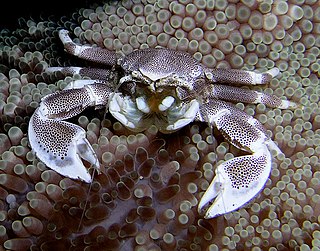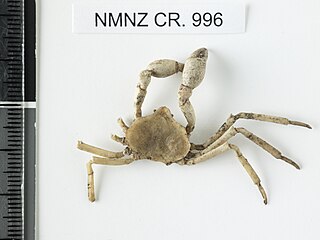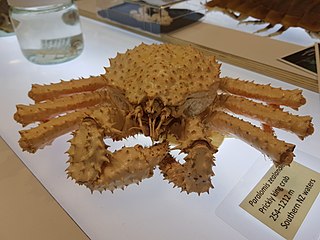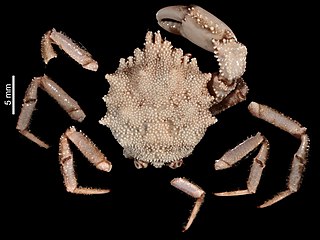
King crabs are decapod crustaceans of the family Lithodidae that are chiefly found in deep waters and are adapted to cold environments. They are composed of two subfamilies: Lithodinae, which tend to inhabit deep waters, are globally distributed, and comprise the majority of the family's species diversity; and Hapalogastrinae, which are endemic to the North Pacific and inhabit exclusively shallow waters. King crabs superficially resemble true crabs but are generally understood to be closest to the pagurid hermit crabs. This placement of king crabs among the hermit crabs is supported by several anatomical peculiarities which are present only in king crabs and hermit crabs, making them a prominent example of carcinisation among decapods. Several species of king crabs, especially in Alaskan and southern South American waters, are targeted by commercial fisheries and have been subject to overfishing.

Xanthidae is a family of crabs known as gorilla crabs, mud crabs, pebble crabs or rubble crabs. Xanthid crabs are often brightly coloured and are highly poisonous, containing toxins which are not destroyed by cooking and for which no antidote is known. The toxins are similar to the tetrodotoxin and saxitoxin produced by puffer fish, and may be produced by bacteria in the genus Vibrio living in symbiosis with the crabs, mostly V. alginolyticus and V. parahaemolyticus.

Pinnotheres is a genus of crabs, including the pea crab. Many species formerly in Pinnotheres have been placed in new genera, such as Zaops ostreus, the oyster crab and Nepinnotheres novaezelandiae, the New Zealand pea crab. The species currently recognised in the genus Pinnotheres are:

Majidae is a family of crabs, comprising around 200 marine species inside 52 genera, with a carapace that is longer than it is broad, and which forms a point at the front. The legs can be very long in some species, leading to the name "spider crab". The exoskeleton is covered with bristles to which the crab attaches algae and other items to act as camouflage.

Macrophthalmus is a genus of crabs which are widespread across the Indo-Pacific. It contains the following species : Species in this genus are often referred to as sentinel crabs.

Pinnotheridae is a family of tiny soft-bodied crabs that live commensally in the mantles of certain bivalve molluscs and the occasional large gastropod mollusc species in genera such as Strombus and Haliotis. Tunicotheres moseri is commensal with a tunicate. The earliest fossils attributable to the Pinnotheridae date from the Danian.

Petrolisthes is a genus of marine porcelain crabs, containing these extant species:

Paralomis is a widely distributed, highly speciose, and morphologically diverse genus of king crabs in the subfamily Lithodinae.

Etisus is a genus of crabs, containing the following extant species:

Amarinus lacustris is a species of freshwater crab from Australia, New Zealand and nearby islands, where it lives in water of various salinities. It grows up to 10 mm (0.4 in) wide, with an H-shaped groove on its back. It is an omnivore and is eaten by crayfish and fish. It was first discovered in Lake Pupuke, near Auckland, and is the only freshwater crab in New Zealand.

The Galatheoidea are a superfamily of decapod crustaceans comprising the porcelain crabs and some squat lobsters. Squat lobsters within the three families of the superfamily Chirostyloidea are not closely related to the squat lobsters within the Galatheoidea. The fossil record of the superfamily extends back to the Middle Jurassic genus Palaeomunidopsis.

Cyclodius is a genus of crabs in the family Xanthidae, containing the following species:

Liomera is a genus of crabs in the family Xanthidae. It contains the following species:

Neolithodes is a genus of king crabs in the subfamily Lithodinae. They are found in all major oceans, both in high and low latitudes. Although there are records from water as shallow as 70 m (230 ft) in cold regions, most records are much deeper, typically 700–2,000 m (2,300–6,600 ft), with the deepest confirmed at 5,238 m (17,185 ft). They are fairly large to large crabs that typically are reddish in color and spiny, although the size of these spines varies depending on species.

Elamena is a genus of crab, containing the following species:

Paralomis zealandica, also known as the prickly king crab, is a species of king crab which lives at a depth between 254–1,212 m (833–3,976 ft) in New Zealand. It has a spiky carapace.

Leptomithrax is a genus of crabs in the family Majidae, first described by Edward J. Miers in 1876. They have been on Earth for 37.2 million years.
Metacrangon is a genus of shrimp belonging to the family Crangonidae.

Trichopeltariidae is a family of crabs in the crustacean order Decapoda.

Paralomis granulosa, also known as the false king crab, the Chilean snow crab, and centollón (Spanish), is a species of king crab. It lives around the southern tip of South America in Chile, Argentina, and the Falkland Islands. It is smaller than Lithodes santolla – a sympatric species of king crab – having a carapace length up to 115 mm (4.5 in), and weighing up to 1.5 kg (3.3 lb).



















